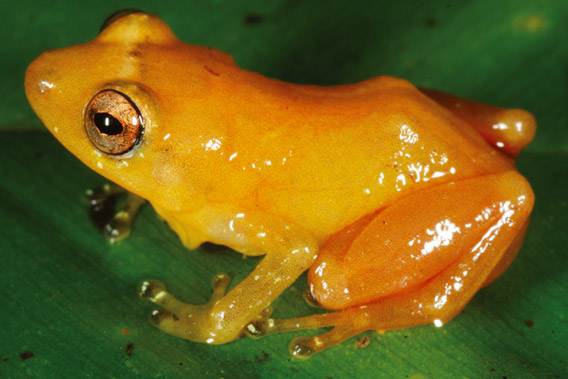
The yellow dyer rain frog (Diasporus citrinobapheus) is a new species of frog discovered in Panama. Photo by: Andreas Hertz.
A beautiful, yellow frog species has been discovered in western Panama, according to a new paper in ZooKeys. Scientists were surprised when handling the new species to find their fingers stained bright yellow by its skin, but even after laboratory research the purpose of this dye remains a mystery.
The new species, named Diasporus citrinobapheus, is a member of the large rain frog family, whose members skip the tadpole stage and instead are born directly from eggs as tiny froglets. Full-grown, the new frog is only 2 centimeters long, which made it difficult for researchers to find.
“Although we recognized that the male mating call of this species differs from all what we had heard before and therefore suspected it to be new, much effort was involved to finally spot it in the dense vegetation,” Andreas Hertz, lead author with Senckenberg Research Institute in Frankfurt am Main, said in a press release.
Hertz and colleagues named the species “citrinobapheus,” which in Greek means “yellow-dyer,” after the stain it left being on the researchers fingers.
“We cannot say whether the dye is any good as a predatory defense, as we could not find any poisonous components,” says Hertz. “Maybe the color is just easily washed out and has no particular function. However, for now, this peculiarity of the new species remains enigmatic.”
The researcher hypothesize that although the dye may not be poisonous it could have a “bitter or otherwise unpalatable taste that might deter certain predators,” according to the paper.
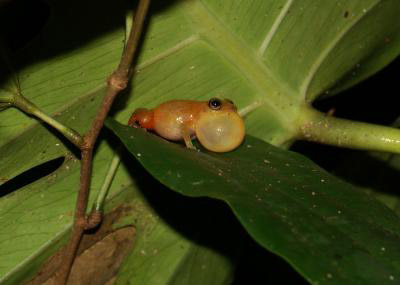
A male yellow dyer rain frog calling. Photo by: Andreas Hertz.
CITATION: Hertz A, Hauenschild F, Lotzkat S, Köhler G (2012) A new golden frog species of the genus Diasporus (Amphibia, Eleutherodactylidae) from the Cordillera Central, western Panama. ZooKeys 196: 23-46. doi: 10.3897/zookeys.196.2774
Related articles
Mad frog bonanza: up to 36 new frogs discovered in tiny Madagascar forest
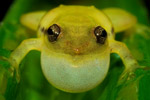
(04/19/2012) A forest less than half the size of Manhattan sports an astounding number of frogs, according to a new paper in Biodiversity Conservation. Two surveys of Madagascar’s Betampona Nature Reserve, which covers 2,228 hectares, has uncovered 76 unique frogs, 36 of which may be new to science. To put this in perspective: the U.S. and Canada combined contain just 88 frog species, but cover an area nearly a million times larger than Betampona.
Two new frogs discovered in Philippines spur calls for more conservation efforts
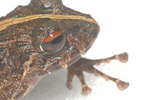
(04/19/2012) Two new frogs have been discovered on the Philippine island of Leyte during a biological survey last year by Fauna and Flora International, which also recorded a wealth of other species. Discovered in November on the island’s Nacolod mountain range, the frogs have yet to be named. The Philippines is one of the world’s global biodiversity hotspots, yet suffers from widespread deforestation and degradation.
Photos: the aye-aye of frogs rediscovered after 62 years
.150.jpg)
(03/27/2012) A pair of researchers have rediscovered a long-lost frog in the tiny African country of Burundi. Known as the Bururi long-fingered frog (Cardioglossa cyaneospila), the species hadn’t been seen for over 60 years—since the Soviet Union tested its first nuclear weapon in 1949—but was rediscovered in Bururi Forest Reserve.
Vampire and bird frogs: discovering new amphibians in Southeast Asia’s threatened forests
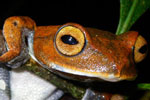
(02/06/2012) In 2009 researchers discovered 19,232 species new to science, most of these were plants and insects, but 148 were amphibians. Even as amphibians face unprecedented challenges—habitat loss, pollution, overharvesting, climate change, and a lethal disease called chytridiomycosis that has pushed a number of species to extinction—new amphibians are still being uncovered at surprising rates. One of the major hotspots for finding new amphibians is the dwindling tropical forests of Southeast Asia.